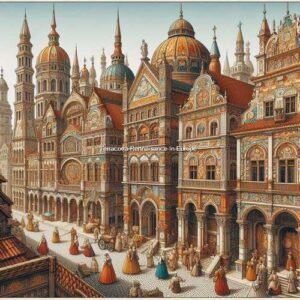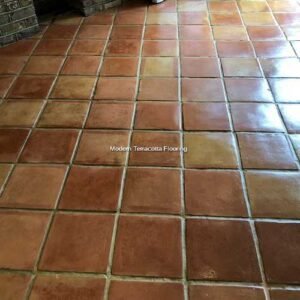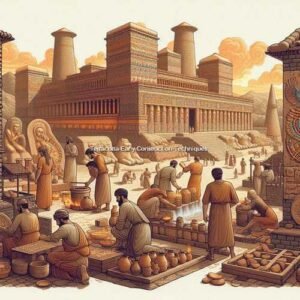Terracotta tiles have a long-standing presence in architecture and design, boasting a fascinating heritage encompassing various cultures and eras. These tiles have proven durable and adapted to changing trends, making them a popular choice for a wide range of uses. In this blog post, we will delve into the intriguing history of Terracotta and explore its widespread applications in modern design.
Ancient Origins: Discovering the Roots of Terracotta Tiles
Origins in Mesopotamia
Terracotta, a material used in construction for centuries, derives its name from the Italian phrase “baked earth.” Its origins can be traced back to the 3rd millennium BC in Mesopotamia, where it was commonly used to construct dwellings and temples. These tiles are perfect for such purposes due to their durability and natural beauty.
In ancient Mesopotamia, Terracotta served a dual purpose—it was not only functional but also carried deep symbolic meaning. The Assyrians and Babylonians extensively used Terracotta to construct palaces and religious sites. Its application served functional and ornamental purposes, highlighting its immense aesthetic and cultural value.
Construction Methods from the Past
The early utilisation of Terracotta in Mesopotamia established the foundation for its lasting impact. Builders in Mesopotamia were well aware of the material's remarkable durability in the face of harsh weather conditions. Creating Terracotta involves shaping clay into desired forms and firing it at high temperatures for a hardened, durable product. This technique has remained virtually the same for millennia.
Evolution in Mediterranean Cultures: The Rise of Terracotta in Greece and Rome
Greece In Antiquity
Terracotta became widely used in the Mediterranean cultures of Greece and Rome, valued for its practicality and pleasing appearance. During ancient times in Greece, Terracotta was a popular material for constructing temples and public buildings. Greek architects excelled in working with Terracotta, creating elaborately shaped tiles arranged in intricate designs.
Advancements in Ancient Rome
The Romans made significant advancements in terracotta tile production techniques. They introduced moulds to ensure uniformity and experimented with various shapes, designs, intricate patterns, and pictorial motifs. Roman builders widely used Terracotta across multiple construction projects, including villas, public baths, and theatres. The development of interlocking roof tiles, known as “tegulae” and “imbrices,” was a remarkable Roman innovation.
Significance in Culture
Terracotta tiles in Roman architecture frequently showcased depictions of mythology and everyday life, reflecting the cultural values and artistic accomplishments of the era. The durability of Terracotta has ensured that many structures have stood the test of time, enabling modern observers to admire the skill of ancient builders.
 Terracotta Renaissance in Europe: Reviving an Ancient Craft
Terracotta Renaissance in Europe: Reviving an Ancient Craft
A New Beginning In The Renaissance
There was a renewed interest in Terracotta during the Renaissance era in Europe. Architects and designers have embraced this versatile material to bring a touch of sophistication to their projects. The tiles beautifully decorated the exteriors of magnificent structures, including grand buildings, churches, and palaces, demonstrating their capacity to elevate visual appeal while offering insulation and safeguarding.
Renowned Renaissance architects, such as Brunelleschi and Michelangelo, skillfully integrated Terracotta into their architectural masterpieces, appreciating its ability to create intricate and captivating exteriors.
Technical and Artistic Advancements
The Renaissance was a time of remarkable technology and art progress. Artisans perfected innovative glazing methods that infused terracotta tiles with rich hues and a lustrous sheen, elevating their allure.
Influence on European Architecture
The extensive use of Terracotta during the Renaissance greatly influenced European architecture, which persisted throughout the Baroque and Rococo eras.
Terracotta in Contemporary Design: Embracing Tradition in Modern Spaces
Modern Applications
Today, Terracotta continues to be popular in contemporary design. Their natural earthy tones and rustic charm lend warmth and character to indoor and outdoor spaces. In modern interior design, terracotta floors create a cosy and inviting atmosphere, often used in kitchens, living rooms, and bathrooms.
Sustainable and Eco-Friendly Choice
Terracotta floors are an eco-friendly option for sustainable building practices. Made from natural clay, they are biodegradable and have a low environmental impact. Their production process requires less energy than other building materials, and their durability means they have a long lifespan, reducing the need for frequent replacements.
Innovative Design Trends
Recent design trends have seen a resurgence in the use of Terracotta, with designers and architects exploring new ways to incorporate this timeless material into their projects. Terracotta tiles easily suit contemporary tastes, from geometric patterns and bold colours to minimalist and industrial aesthetics.
 Common Uses and Applications: Versatile and Functional Terracotta Tiles
Common Uses and Applications: Versatile and Functional Terracotta Tiles
Floor Covering
Terracotta can create captivating feature walls that enhance any room's texture and visual appeal. They are highly effective in spaces that strive for a rustic or Mediterranean-inspired look.
Wall Covering
Terracotta can create stunning feature walls, adding texture and visual interest to any room. They work exceptionally well in spaces aiming for a rustic or Mediterranean-inspired aesthetic.
Roofing Material
Terracotta is a highly durable material, making it excellent for roofing. Terracotta offers exceptional protection from the elements while adding a unique charm to any building.
Stylish Embellishments
Terracotta tiles are famous for decorative accents in various architectural elements, including arches, columns, and cornices. Their adaptability enables designers to craft one-of-a-kind and visually captivating elements.
Landscape And Garden Use
Terracotta tiles are a great choice for enhancing the aesthetic appeal of garden paths, courtyards, and poolside areas. They bring a touch of natural beauty to outdoor spaces, and their earthy tones and textured surfaces effortlessly harmonise with the surrounding natural environment.
FAQs About Terracotta Tiles
What advantages do terracotta tiles offer in sustainable architecture?
Terracotta tiles are crafted with the utmost care, using natural clay, ensuring their eco-friendly nature and minimal environmental impact. With their exceptional durability and impressive lifespan, there is no need for frequent replacements.
What are some ways to improve the colour of terracotta tiles?
Consistent cleaning and effective sealing can help to enhance the colour. Utilising a colour-enhancing sealer can further accentuate the inherent shades.
Are there any current design trends for terracotta tiles?
Indeed, contemporary design incorporates geometric patterns and vibrant colours and seamlessly blends with minimalist and industrial aesthetics.
What are the recommended methods for installing terracotta tiles?
Proper surface preparation, selecting the appropriate adhesive, and allowing ample drying time are crucial for optimal results. Expert installation guarantees a secure and reliable placement.
Is it possible to utilise terracotta tiles for heated flooring systems?
Indeed, terracotta tiles are well-suited for heated flooring systems, ensuring effective heat distribution and a pleasant temperature.
Relevant Hyperlinked Sources
The post: Terracotta Tiles: A Fascinating Journey Through History and Time appeared first on TileCleaningSurrey.co.uk
The Article Terracotta Tiles: An Engaging Exploration of the Past and Present appeared first on https://fabritec.org
The Article Terracotta Tiles: An Engaging Exploration of the Past and Present Was Found On https://limitsofstrategy.com




This is such an interesting dive into the world of terracotta tiles! It’s fascinating how something as seemingly simple as a tile can hold so much history and cultural significance. I’ve been really drawn to the aesthetic of terracotta in recent years. There’s something about the warmth of the color and the texture that adds a unique charm to spaces—especially in kitchens and outdoor areas.
I’m really glad you found the article interesting! It’s true that terracotta tiles often fly under the radar when people think about flooring options, but they carry a lot of charm and history. The way they’ve been used in different cultures—from ancient Mediterranean homes to modern rustic kitchens—really showcases how versatile they are.
It really is intriguing how an element as simple as terracotta tiles can weave together stories from different cultures and eras. I’ve also found myself drawn to the warmth they bring—there’s something about that earthy hue that makes a space feel inviting and grounded.
It’s true—terracotta tiles seem to share this universal quality that transcends time and geography. I think their history is a testament to their enduring appeal; they’ve been used in everything from ancient Roman architecture to Mediterranean villas, and each application carries its own unique story. It’s fascinating how materials like this can connect us to different cultures, isn’t it?
You’ve touched on a compelling aspect of terracotta tiles—their ability to weave through the fabric of different cultures over centuries. It’s interesting to think about how these tiles aren’t just materials; they’re carriers of stories and traditions. In ancient Rome, for example, the way they captured heat and reflected light was not only practical but also aesthetic, turning mundane spaces into architectural statements.
I completely agree with you about terracotta tiles. There’s something incredibly grounding about them, as if they carry the whispers of all the places they’ve been. I’ve always found it interesting how materials like these not only have an aesthetic appeal but also a functional one, especially in different climates. In hotter regions, for example, they can help regulate indoor temperatures, contributing to a more comfortable living environment.
You’ve captured something essential about terracotta tiles. They do have a unique ability to tell stories, don’t they? It’s fascinating to think about how these simple, earthy materials have been used across cultures, from ancient Mediterranean homes to modern spaces. Each tile carries a history, reflecting the hands that crafted it and the environments it lived in.
“I’m glad you feel that way! If you’re interested in exploring a diverse collection of terracotta tiles that embody those captivating stories and warm, inviting tones, check this out.”
https://cnisclub.org/quillbot
It’s great to hear that you’ve been drawn to terracotta tiles as well. There’s definitely something special about their warmth and texture. I love how they can soften a space and create a cozy, inviting atmosphere, especially in kitchens and outdoor areas where we often gather with family and friends.
I’m glad you found the article engaging! Terracotta tiles do have that special something, don’t they? The warmth in their color really creates a cozy vibe, especially in kitchens where so much of our daily lives unfold. And outdoor spaces? They just come alive with the earthy tones and textures.
I’m glad you found it interesting! If you’re looking to explore more about terracotta tiles and how to incorporate their beauty into your spaces, check out this curated selection of stunning options.
https://cnisclub.org/octopus
You raise an interesting point about the warmth and texture of terracotta tiles. There’s something captivating about how they evoke a sense of nature and history in our living spaces. However, one aspect that’s often overlooked is their practicality. Terracotta can absorb moisture, which is something to consider if you’re thinking about using them in kitchens or outdoor areas. Proper sealing is essential to maintain their beauty and functionality over time.
I’m glad you found the article insightful! If you’re looking to incorporate that warm charm of terracotta into your own spaces, check out this collection of stunning tiles that capture the beauty and history we discussed.
https://cnisclub.org/quillbot
It’s interesting to see Terracotta’s rich history being highlighted, especially its dual functionality and symbolism in ancient Mesopotamia. However, one aspect I find particularly fascinating is how the modern interpretation of Terracotta often overlooks these cultural connotations. While we appreciate its aesthetic in contemporary design, I wonder if we can connect the artistry of these ancient tiles to broader discussions about sustainability in architecture today.
It’s great to hear your thoughts on Terracotta and its modern interpretations. You raise an important point about how the rich cultural stories behind these materials can sometimes get lost in the shuffle of contemporary design.
It’s fascinating how much history is embedded in something as seemingly simple as terracotta. When you think about it, this material has been a part of human life for thousands of years, serving practical needs while also expressing cultural identities. It’s easy to overlook those narratives in modern design, where functionality and minimalism often take precedence.
You raise an interesting point about terracotta and its blend of practicality and cultural significance. When we look at the uses of terracotta throughout history—think of ancient pottery, roof tiles, or even the famous Terracotta Army—it’s remarkable how this unassuming material has bridged everyday life and artistic expression.
Absolutely! If you’re curious to explore more about the rich stories and cultural significance behind terracotta and how it continues to influence modern design, check out this insightful resource.
https://cnisclub.org/octopus
Your point about the modern interpretation of Terracotta is very relevant. As we admire its aesthetic qualities today, it’s easy to forget the deeper meanings and functions it carried in ancient cultures. The decorative beauty that attracts contemporary designers often overshadows the material’s significance in rituals and daily life back then.
You bring up such an important point about the modern interpretation of Terracotta and the risk of losing those deeper cultural meanings. It’s fascinating how materials like Terracotta, with their significant histories, can often become just another aesthetic choice in contemporary design. The symbolism it carried in ancient Mesopotamia, from spirituality to practicality, really deserves more attention, especially as we navigate our current design ethos.
It’s fascinating to think about how terracotta tiles have transcended time and cultures, establishing themselves as both practical and symbolic elements in architecture. I’ve always appreciated how materials can tell the story of their origins, and terracotta certainly embodies a rich history that reflects the ingenuity of ancient civilizations.
It’s great to hear your thoughts on terracotta tiles. They really do have a unique ability to connect us to the past. One aspect I find particularly intriguing is how different cultures have adapted terracotta for their own environments and needs. For instance, in Mediterranean regions, you’ll often see these tiles used not just for floors but also as roof tiles, demonstrating their versatility.
You’re right; terracotta tiles have such a rich history and bring a wonderful warmth to spaces. It’s fascinating to think about how cultures have used this material so creatively across various climates and settings. For example, in many Mediterranean houses, the use of terracotta for roofs isn’t just about aesthetics but also about functionality—those tiles help regulate temperature by providing insulation.
It’s true, the way terracotta tiles weave together functionality and aesthetic is really remarkable. I love how you pointed out their insulating properties; it speaks to a deep understanding of the local climate and available materials, doesn’t it? In many ways, terracotta embodies the balance between nature and architecture.
You’ve hit on something so essential with your thoughts about terracotta. It really does show how architecture can respond to the environment in practical yet beautiful ways. What’s interesting is that these tiles aren’t just pretty; they’ve been part of so many cultures for centuries. They’ve helped to keep homes cool in the summer and warm in the winter, which is something many modern materials often overlook.
You bring up an interesting point about the practical benefits of terracotta tiles, especially in Mediterranean architecture. It’s true that beyond their aesthetic appeal, these tiles play a crucial role in climate adaptation. The way they absorb heat during the day and release it slowly at night helps keep homes comfortable without heavy reliance on modern heating or cooling systems.
Absolutely, the versatility of terracotta tiles is truly remarkable! If you’re interested in exploring how these timeless materials can enhance your own space, check out this collection for some inspiring ideas.
https://cnisclub.org/quillbot
You’ve touched on an interesting aspect of terracotta that often gets overlooked. The functionality really ties into the cultural identity of an area. In Mediterranean climates, those tiles not only add character but also play a vital role in the overall climate control of homes. It’s intriguing how local resources and architectural choices reflect the needs and lifestyles of the people.
It’s interesting how materials like terracotta can connect us to different cultures and histories. The way it blends function with aesthetics truly reflects the ingenuity of the people who designed those spaces. I’ve been reading about traditional building methods and how they often incorporate locally available materials, which makes architecture feel organic and in harmony with the environment.
You’ve touched on something really special there. Terracotta is one of those materials that does more than just serve a purpose; it has a story to tell. It’s interesting to think about how something so simple and earthy can link us to various cultures, isn’t it? Each region’s use of terracotta can show us their unique needs and their relationship with the land.
“Absolutely, the blend of functionality and aesthetics in traditional materials really highlights the brilliance of local architecture! If you’re interested in exploring more about these unique building methods and their cultural significance, check out this insightful resource.”
https://cnisclub.org/quillbot
I completely agree; there’s something timeless about terracotta tiles that resonates deeply with so many cultures. The way they blend beauty with practicality is truly admirable. In addition to their temperature-regulating properties, I think it’s interesting how the aesthetic appeal of terracotta also plays a role in the overall health of a space. Natural materials like these can create a more inviting atmosphere, contributing to mental well-being—there’s a reason we often seek out warmth and texture in our environments.
You bring up such a fascinating point about the adaptability of terracotta across cultures. It’s amazing how a material so rooted in history can still be so relevant today. The Mediterranean use of terracotta tiles as roofing is particularly impressive when you consider their functionality and aesthetic appeal. Those curved tiles are not just beautiful; they serve a practical purpose in keeping homes cool under the hot sun.
You’ve touched on something really intriguing about terracotta tiles. It’s interesting how they serve not only practical purposes—like durability and insulation—but also connect us to ancient crafting techniques. When you walk on a terracotta floor, you can almost feel the hands of artisans from centuries past, each tile a piece of their story.
Absolutely, the story of terracotta tiles is truly captivating! If you’re interested in exploring their rich history and applications further, check out this insightful resource.
https://cnisclub.org/octopus
Your observation on the transcendent nature of terracotta tiles really gets to the heart of what makes architectural materials so compelling. The way that terracotta has journeyed through time and across various cultures is a testament to its versatility and enduring appeal. It’s interesting to think about how this material, first used by ancient civilizations, continues to shape our understanding of design and functionality in contemporary settings.
Your thoughts on terracotta tiles really resonate with me. It’s fascinating to think about how this material we associate with homes and aesthetics also carries stories from ancient civilizations. Each tile is like a small piece of history, showing us what people valued in terms of design and functionality at different times and places.
“Explore how terracotta tiles can elevate your space by delving into their rich history and modern applications.”
https://cnisclub.org/quillbot
You’ve touched on something really interesting about terracotta. It’s amazing how this simple material, made just from clay and fire, has made such a mark across different cultures and eras. It’s like a blank canvas that ancient artisans transformed with their skills and creativity.
This exploration of terracotta tiles truly sparks my imagination! I find it fascinating how such a practical material has woven itself into the fabric of so many cultures throughout history. It’s intriguing to think about how these tiles not only served as utilitarian building components but also as vessels of cultural expression, carrying symbolic meanings for the civilizations that crafted them.
It’s great to hear how the article resonated with you! You’re spot on about the dual role terracotta tiles play. On one hand, they’re practical, durable, and accessible building materials, but they also tell fascinating stories about the cultures that made them. I love how each design and pattern can reflect local traditions, beliefs, and even social status.
“Discover something special—click here to explore!”
https://cnisclub.org/quillbot
I completely agree with you; it’s fascinating how something as simple as terracotta tiles can carry so much weight in terms of cultural significance. Each tile has its own story, often reflecting the artistic traditions and values of the people who created them. For instance, the intricate designs found in Mediterranean tiles can reveal insights into the region’s history, trade, and even interactions between various cultures.
You raise some valuable points about the cultural significance of terracotta tiles. It’s intriguing how something as commonplace as a tile can serve as a canvas for expressing a culture’s artistic nuances and historical narratives. The Mediterranean region, with its rich and diverse heritage, exemplifies this beautifully.
Absolutely! If you’re interested in exploring more about the rich history and artistry behind terracotta tiles, I invite you to check out this insightful resource.
https://cnisclub.org/octopus
It’s really refreshing to hear your thoughts on terracotta tiles. They definitely have a unique way of bridging practicality with artistry. I often think about how materials like these not only serve a basic function but also reflect the cultural stories and values of the people who make them.
I find it fascinating how terracotta tiles have woven themselves through so many cultures and eras, acting not just as a building material but as a canvas for individual expression and cultural significance. The durability you mention really does reflect human ingenuity—it’s incredible that something created thousands of years ago can still be relevant today.
You’ve nailed it. Terracotta tiles really do tell a story that spans ages and continents. It’s wild to think about how simple clay can be transformed into something so beautiful and durable. Each design often carries cultural meanings that can vary drastically from one region to another, yet there’s that underlying thread connecting them all.
“I’m glad you found the enduring charm of terracotta tiles captivating! If you’re interested in exploring some stunning examples and how they can enhance contemporary spaces, check out this link.”
https://cnisclub.org/quillbot